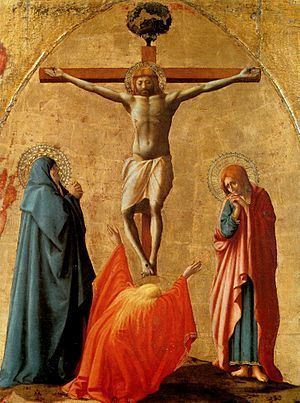Year circa 1426 Artist Masaccio Created 1426–1426 Genre Christian art | Type panel Location Naples Period Early renaissance Subject Crucifix, Crucifixion | |
 | ||
Dimensions 83 cm × 300 cm (33 in × 120 in) Similar Masaccio artwork, Early renaissance artwork, Christian art | ||
Van der weyden crucifixion with the virgin and saint john
Crucifixion is a painting by the Italian Renaissance artist Masaccio.
A chapel in Santa Maria del Carmine in Pisa commissioned an altarpiece from Masaccio on February 19, 1426 for the sum of 80 florins. Payment for the work was recorded on December 26 of that year. The altarpiece was dismantled and dispersed in the 18th century, but an attempted reconstruction was made possible due to a detailed description of the work by Vasari. Eleven pieces have been found as of 2010, and they are insufficient to reliably reconstruct the whole work. The Crucifixion is one of the surviving panels connected with the Pisa Altarpiece.
The Crucifixion was placed above the central panel of the altarpiece, which represented the Virgin enthroned with the baby Jesus on her lap, flanked by 2 pairs of angels. Although the panel unnaturalistically represents the narrative against a gold background (a medieval formula for representing sacred scenes), Masaccio creates an effect of reality by depicting the event from below, as the viewer standing before the altar truly saw it. In this way, he attempts to tie the viewer to the scene, to make the sacred accessible to the ordinary Christian.
This is not the crucifixion in the mosaic of the dormition
